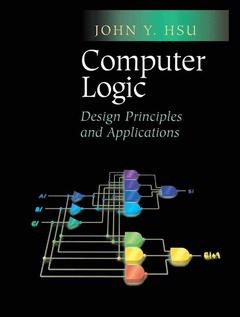Description
Computer Logic, 2002
Design Principles and Applications
Language: English
Subjects for Computer Logic:
Computer Logic
Publication date: 09-2012
198 p. · 17.8x23.5 cm · Paperback
Publication date: 09-2012
198 p. · 17.8x23.5 cm · Paperback
Computer logic : design principles and applications
198 p. · 17.8x25.4 cm · Hardback
198 p. · 17.8x25.4 cm · Hardback
Description
/li>Contents
/li>
An understanding of modern computer logic - incorporating core knowledge of number systems, number conversions, Boolean algebra, memories, and logic circuits - is fundamental to further study of computer architectures, system software, and computer networks. Computer Logic: Design Principles and Applications introduces and describes the relevant concepts, principles and applications of modern computer logic design. The book is self-contained, with an introductory chapter that concisely covers the history of computing devices, as well as number systems, number conversions, signed and unsigned integers, external code, and digital and digitizing concepts. Dedicated chapters on Boolean algebra, transistor circuits, combinatorial logic circuits, and sequential logic circuits round off the work. The emphasis is on design and applications.
1 Introduction.- 1.1 Prolog.- 1.2 Digital Concept.- 1.3 Number Systems.- 1.4 Number Conversions.- 1.5 Unsigned Integers Vs. Signed Integers.- 1.6 External Codes.- 1.7 Digitizing Concept.- 1.8 Summary Points.- Problems.- 2 Boolean Algebra.- 2.1 Boolean Constant Vs. Boolean Variable.- 2.2 Basic Laws.- 2.3 Basic Theorems.- 2.4 Other Logical Operators.- 2.5 Algebraic Simplifications.- 2.6 Karnaugh Maps.- 2.7 Summary Points.- Problems.- 3 Transistor Circuits.- 3.1 Introduction.- 3.2 Scale of Integration.- 3.3 Bipolar Transistors.- 3.4 Unipolar Transistors.- 3.5 Electronic Design Issues.- 3.6 Digital Waveforms.- 3.7 Summary Points.- Problems.- 4 Combinational Logic Circuits.- 4.1 Basic Logic Gates.- 4.2 Other Types of Logic Gates.- 4.3 Combinational Circuit Design Cases.- 4.4 Binary Adders.- 4.5 Carry Propagated Adder.- 4.6 Multiplication Tree.- 4.7 Programmable Logic Arrays.- 4.8 Memories.- 4.9 Summary Points.- Problems.- 5 Sequential Logic Circuits.- 5.1 Sequential Circuit Elements.- 5.2 RS Flip-Flops.- 5.3 Other Types of Flip-Flops.- 5.4 Sequential Circuit Design Cases.- 5.5 Sequencer t2167.- 5.7 Verilog.- 5.8 Summary Points.- Problems.- APPENDIX A Acronyms and Abbreviations.- APPENDIX B Logic Symbols and Equations.- References.
© 2024 LAVOISIER S.A.S.
These books may interest you

The Complete Verilog Book 158.24 €



